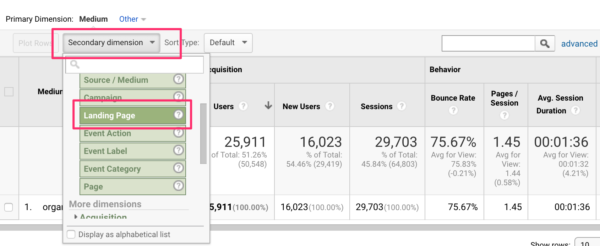An Unbiased View of What Is A Secondary Dimension In Google Analytics
Wiki Article
The Only Guide to What Is A Secondary Dimension In Google Analytics
Table of ContentsWhat Is A Secondary Dimension In Google Analytics Things To Know Before You BuyWhat Is A Secondary Dimension In Google Analytics Things To Know Before You BuyUnknown Facts About What Is A Secondary Dimension In Google AnalyticsThe Ultimate Guide To What Is A Secondary Dimension In Google AnalyticsWhat Is A Secondary Dimension In Google Analytics Things To Know Before You Get ThisWhat Is A Secondary Dimension In Google Analytics Things To Know Before You Buy
Its dimensions can be (however are not limited to): Transaction ID Voucher code Newest web traffic resource, etc. That occasion's custom measurements might be: Login approach Customer ID, and so on.Thus customized dimensions are required. In Google Analytics, you will certainly not locate any type of measurements relevant particularly to on the internet training courses.

9%+ of services utilizing GA have absolutely nothing to do with courses. And also that's why anything related particularly to on the internet courses need to be set up by hand. Go Into Personalized Capacities. In this blog message, I will certainly not dive deeper into custom measurements in Universal Analytics. If you wish to do so, read this overview.
The Main Principles Of What Is A Secondary Dimension In Google Analytics
The extent defines to which occasions the dimension will apply. In Universal Analytics, there were 4 extents: User-scoped personalized measurements are put on all the hits of a user (hit is an event, pageview, etc). If you send Customer ID as a custom dimension, it will be applied to all the hits of that certain session As well as to all the future hits sent by that user (as long as the GA cookie remains the very same).You can send the session ID custom measurement, as well as even if you send it with the last event of the session, all the previous events (of the exact same session) will obtain the worth. This is performed in the backend of Google Analytics. measurement uses only to that particular event/hit (with which the dimension was sent out).
Also if you send several items with the very same transaction, each product might have various worths in their product-scoped custom-made measurements, e. g.

Why am I telling you this? In Google Analytics 4, the session range is no much longer available (at the very least in custom dimensions). If you desire to use a measurement to all the occasions of a specific session, you must send out that measurement with every event (that can be done on the code degree (gtag) or in GTM) (What Is A Secondary Dimension In Google Analytics).
It can be in a cookie, information layer, or someplace else. From now on, custom-made dimensions are either hit-scoped or user-scoped (formerly called User Characteristics). User-scoped customized dimensions in GA4 job similarly to the user-scoped measurements in Universal Analytics but with some distinctions: In Universal Analytics, a user-scoped customized measurement (collection in the center of the customer session) was applied to EVERY occasion of the exact same session (even if some occasion took place prior to the dimension was established).
Rumored Buzz on What Is A Secondary Dimension In Google Analytics
Despite the fact that you can send custom item information to GA4, right now, there is no way to see it in reports correctly. Ideally, this will be altered in the future. Or am I missing something? (let me understand). GA4 now supports item-scoped custom dimensions. At some point in the past, Google stated that session-scoped custom-made measurements in GA4 would be available as well.But when it pertains their website to custom-made measurements, this extent is still not offered. And currently, let's relocate to the second component of this article, where I will show you exactly how to set up custom-made dimensions and where to locate them in Google Analytics 4 reports. First, let me begin with a general summary of the process, and afterwards we'll have a look at an instance.
You can simply send the event name, claim, "joined_waiting_list" and also after that consist of the parameter "course_name".
Fascination About What Is A Secondary Dimension In Google Analytics
In that instance, you will certainly need to: Register a parameter as a custom-made interpretation Start sending custom-made specifications with the events you want visit this page The order DOES NOT matter right here. You need to do that pretty much at the very same time. If you begin sending out the parameter to Google Analytics 4 and also only register it as a personalized measurement, claim, one week later, your reports will be missing out on that week of information (due to the fact that the registration of a custom more helpful hints dimension is not retroactive).Every time a site visitor clicks on a menu item, I will certainly send out an event and 2 extra specifications (that I will later register as personalized measurements), menu_item_url, and menu_item_name.: Food selection link click monitoring trigger problems differ on many websites (since of different click classes, IDs, and so on). Attempt to do your ideal to apply this example.
Go to Google Tag Manager > Causes > New > Simply Hyperlinks. What Is A Secondary Dimension In Google Analytics. Keep the trigger readied to "All link clicks" and also save the trigger. By developing this trigger, we will enable the link-tracking performance in Google Tag Manager. Then go to Variables > Configure (in the "Integrated Variables" section) and make it possible for all Click-related variables.
The 10-Second Trick For What Is A Secondary Dimension In Google Analytics
Go to your site and also click any of the food selection web links. Click the first Link, Click event and also go to the Variables tab of the preview setting.
Report this wiki page